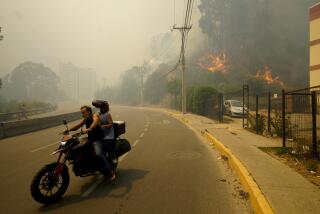Global warming played a role in Incas’ rise, report says
- Share via
Global warming is not necessarily always bad.
A 400-year warm spell in South America fueled the Incas’ rise, British archaeologists reported Monday, helping them build the largest empire that ever ruled the continent.
A several-degree increase in temperature allowed the Incas to move higher into the Andes mountains, opening up new farmland and providing a water source through the gradual melting of glaciers at the top of those mountains, paleoecologist Alex Chepstow-Lusty of the French Institute of Andean Studies in Lima reported online Monday in the journal Climate of the Past.
“They were highly organized and they had a sophisticated [governance], but it wouldn’t have counted a jot without being underpinned by the warming of the climate,” he said in a telephone interview.
Other experts were cautious about his interpretation. “The premise that the Incan expansion was driven by climate change is quite revolutionary,” said archaeologist Mark Bush of the Florida Institute of Technology in Melbourne.
Confirming it will require a great deal more work for paleoecologists and archaeologists alike.
The new research is important because “data on Andean climate during this time period are scant,” said archaeologist Warren Church of Columbus State University in Georgia, who works in Peru. “However, it is important to remember that climates do not make empires. People do.”
Chepstow-Lusty, geographer Mick Frogley of the University of Sussex and their colleagues have been studying a 26-foot-long core of mud drilled from the sacred Lake Marcacocha in the Patacancha Valley of Peru, near Cuzco. Seeds, pollen, charcoal bits and other debris from successive layers in the core paint a picture of climate and agriculture in the region for 4,000 years.
Analysis of the core showed that a major drought began in the region around the year 880 and lasted for at least 100 years.
That drought, Chepstow-Lusty speculated, may have been the cause of the demise of the Wari empire, which lasted from 550 to 1000. The region was also colder than normal for the 3,000 years before 1000.
Beginning about 1150, the climate began warming and eventually got “several degrees centigrade” warmer, Chepstow-Lusty said. That had the net effect of extending arable regions to an altitude about 300 yards higher in the mountains, he suggested, vastly extending the area that could be cultivated. It also might have caused the Peruvian glaciers to melt slowly, providing water that the Incas captured with large irrigation systems and agricultural terraces.
The major evidence for the warming, Chepstow-Lusty said, was the appearance of alder-like trees that hadn’t been seen in the region before, as well as increased insect activity. The trees, which normally grow in warmer climates, grow well in poor soil and fertilize it by converting nitrogen from the atmosphere into a usable form.
The increased cultivation would have led to large surpluses of maize and potatoes, the researchers speculated, freeing the Incas to undertake other activities, including building monuments and roads and creating a large standing army that allowed them to conquer nearby peoples.
By the time the Spanish arrived in 1533, the Incas controlled an area that stretched from what is now the Colombian border with Ecuador to the middle of Chile, with more than 8 million inhabitants. When the Spanish arrived, they noted that the Incas had enough food in warehouses to last for 10 years.
The Incan empire ended after the arrival of the Spanish, who inadvertently brought diseases that devastated the population, allowing the invaders to conquer the survivors and push them to the highest altitudes, where they are still marginalized economically.
The story has a powerful moral for today, Chepstow-Lusty said. Peru is one of the countries most threatened by global warming, and the glaciers that provide much of the water for the capital, Lima, are rapidly melting and are expected to be gone in 20 years. The terraces that previously trapped water for agriculture have fallen into disuse, and the predominant tree in the region is the eucalyptus, which saps what water remains in the soil and deposits resins that poison other plant life.
Chepstow-Lusty called for removal of the eucalyptus tree and a massive reforestation effort with alder or similar trees to replenish the soil, as well as repair of the derelict irrigation systems so they can once more support agriculture.
But Church, who also works in Peru, cautioned that without more research, such an approach could be “premature and risky.”
--
More to Read
Sign up for Essential California
The most important California stories and recommendations in your inbox every morning.
You may occasionally receive promotional content from the Los Angeles Times.










